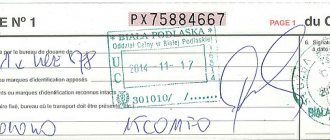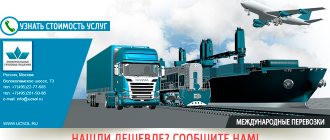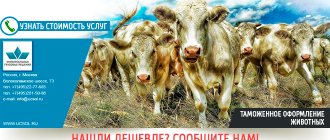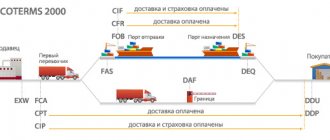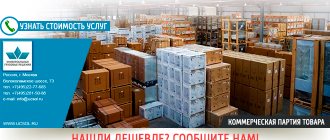“TIR”, or as it is commonly called throughout the world – “TIR” is a book for International Road Transport. It is a small notebook with tear-off pages. The official name is “TIR Carnet” or “Carnet TIR”.
In 1975, the “Convention of International Transport by Road”, developed by international freight carriers, transport companies and ministries of transport of many European countries after the end of the Great Patriotic War, came into force. Its goal is to maximize the simplification of cargo transportation between the countries participating in the Convention.
The IRU is responsible for the TIR system. "IRU" is an international road transport union, which also has its representative office in Russia - the organization "ASMAP". However, the validity of the TIR book in Russia was greatly limited two years ago.
What is the TIR Carnet?
This is what the cover of the “book” looks like. The book itself consists of:
- Yellow front cover
- Protocol
- White and green tear-off sheets
- Yellow cargo manifest
- Back tear cover
Each TIR Carnet is assigned its own number and limited validity period. To obtain a “book,” you must obtain permission to carry out international transportation from the Federal Customs Service. After this, you need to make a payment and join the ASMAP organization. You will not be issued a TIR Carnet if you do not have customs certificates for semi-trailers and certification for vehicles for international freight transport.
Manifesto "TIR Carnet"
TIR Carnet contains all the necessary information for international cargo transportation, namely:
- Country of loading and unloading
- Place of customs clearance and customs clearance of goods
- Sequence of passage through customs authorities
- Description of the goods, codes of goods according to the nomenclature of foreign trade activities, weight of the goods and occupied cargo spaces in the back of a heavy truck
- Numbered list of all documents for goods and transport
- Numbered list of seals and other customs marks
It should be noted that you can also fill out the “TIR book” yourself. However, there is a high probability of making ridiculous mistakes when filling out and problems may arise at customs because of this, so it is better to entrust this to third parties who are engaged in filling out “books” professionally.
Depending on the complexity of the transportation route, you must carefully think through the transportation route and clearly know how many times you need to open and close the “TIR” at customs. Therefore, there are various “TIR books” from 4 to 20 sheets, the cost of which also differs.
Abbreviation TIR (TIR) - what does it mean?
The inscription "TIR" on trucks is quite common, what does it mean? This abbreviation, translated from French into Russian, sounds like “international road transport” - TIR decoding. In other words, these letters - TIR or TIR - denote an international system that allows, according to a certain procedure, to transport goods across borders between countries that have joined this agreement.
The TIR system operates based on the UN Customs Convention on the International Transport of Goods. The system is managed by the IRU (International Road Transport Union). Today, 67 countries and the European Union participate in this system. Detailed information about the TIR Convention is contained in the TIR Handbook, which can be found on the IRU website, and useful information about road container transport is here.
Having a problem? Call our customs specialist:
8-495-565-32-46
What is a TIR Carnet (Carnet TIR)?
When transporting goods using TIR, the goods are recorded in a document called the “TIR Book” - a document with tear-off sheets that are confiscated during the next customs check of the vehicle (one sheet for each checkpoint).
Thus, we are talking about a customs document accompanying the goods, which gives its owner the right to move the goods declared in it, crossing the borders of the specified countries and using a simplified inspection procedure. We advise you to familiarize yourself with the terms of delivery according to INCOTERMS 2010; this information is useful for debutants in international trade. The forms of these documents are sold by organizations determined by the internal decisions of the countries participating in the TIR system. In Russia, this is ASMAP (Association of International Road Carriers), located in Moscow. The procedure for obtaining and issuing TIR Carnets, the list of documents required for this, the current cost of the carnet, other information on related issues, including instructions for the preparation and use of documents necessary for international transportation are the prerogative of ASMAP and can be obtained from the website of this organization.
TIR Carnet is a document that looks like a large-format notepad, which contains:
- mustard colored cover;
- cargo manifest in yellow;
- pairs of double white and green tear-off sheets with spines;
- protocol sheet;
- endpaper of the cover and its tear-off part.
The book has its own unique number consisting of two Latin letters and seven numbers. Its validity period is limited - a stamp on its cover indicates the last period of its validity.
For each vehicle for one transportation, the book is filled out in one copy, valid until the end of the transportation. During the transportation of cargo, the customs authorities of the countries whose borders the vehicle crosses only check the integrity of the previously completed customs seal. After checking, if the integrity of the seals is not broken, the employee of the current customs authority removes one sheet of the TIR Carnet and fills in the corresponding counterfoil remaining in it.
The complete procedure for filling out this document is given in the corresponding instructions, also in Russian, distributed by the International Road Transport Union (IRU) and available at ASMAP and its branches in the regions.
The ASMAP Association is responsible for the guarantees provided to the recipient regarding the safety of the cargo transported to him and is legally responsible for the activities of road carriers using TIR Carnets.
If there is a justified claim against any of the road carriers, ASMAP covers this claim as a guarantor and, only then, sorts out the relationship with the violator.
Everything said here does not terminate the right of any customs office crossed by a vehicle to carry out full control of both the vehicle and the cargo transported by it, if it deems it necessary.
Cargo manifest TIR CARNET
This document contains the data necessary for transporting goods between different countries.
- Sending country and receiving country.
- Sending customs and receiving customs.
- Customs in the order in which they are cleared.
- Information about the transported cargo: name, HS code, gross and net weight, number of pieces.
- Information on the number of places and instructions on the relevant customs offices of destination.
- List of transport documents accompanying the goods, indicating their numbers.
- Registration number of the vehicle performing the transportation.
- Numbers of applied seals, seals and other customs marks.
If you have relevant experience, then you can fill out everything necessary yourself. However, for this it is necessary to carefully study many different papers, often designed rather clumsily. Therefore, it is better to entrust the filling out of documents to specialists, usually available at customs. You can find out how much the services of a customs broker cost and how they can help a foreign trade participant in one of our articles.
Transportation invoices
CMR waybills (CMR) are prepared in at least three copies, each of which is certified by both the sender and the carrier.
The sender keeps the original copy, and the other two go along with the cargo. The declaration system (TIR-EPD) of the IRU is currently supported by 31 countries.
Upon completion of transportation, one of the available copies is certified by the recipient and returned to the carrier. The recipient of the cargo receives the last copy. For the completeness and accuracy of the data in the CMR, all responsibility lies with the person whose seal is in the 22nd column of the document. We have already talked in more detail about what CMR is in a previous article. It is necessary to especially emphasize the importance of matching the data specified in all copies of not only this document, but in general in all transportation documents.
The principle of operation of the “TIR book”. How to fill out the “TIR book” correctly?
During its passage, authorized customs officers tear off the pages of the TIR Carnet one by one, leaving only the spines for the carrier.
All sheets are paired - one white (for opening), the second green (for closing). The opening/closing of TIR should not be confused with the actual start/end of cargo transportation. The procedure for opening and closing a TIR must be completed at each customs office, but the maximum number of destination customs offices is only three.
You can find guidance on filling out the TIR Carnet here.
Operation of TIR and other transit procedures on the territory of the Republic of Belarus
In Belarus, the TIR Carnet is valid within the framework of the 1975 Convention and does not have the same restrictions as in Russia.
The transit of goods through the territory of the republic is carried out with the permission of the customs authorities of the Republic of Belarus and under their control, in accordance with world practice. Belarus is a party to various international conventions and offers freight forwarding companies, as well as cargo carriers, to use one of the procedures when carrying out transit:
- TIR
- ATA
- SMGS
- CIM/SMGS
In case of transit using one of the above international procedures, the carrier is exempt from the obligation to fill out the transit declaration of the Republic of Belarus. For transportation, it will be enough to provide one of the following documents:
- TIR book
- Carnet ATA
- SMGS (for rail transport)
- CIM/SMGS consignment note
All these documents must be issued in accordance with international conventions, such as, for example, the “TIR Carnet” in accordance with the “TIR Convention” of 1975.
In the Republic of Belarus, customs inspection is carried out within 24 hours from the moment the decision to conduct it is made. In accordance with the TIR Convention, all documents for transport and transported goods must be attached to the TIR Carnet in order to speed up customs clearance and control of goods transported through the territory of the Republic.
Author: Stanislav S
Ministry of Foreign Affairs of the Russian Federation
(TIR CONVENTION, 1975)
(Reference Information)
27-01-2004
Work on a simplified transit system for international road transport (TIR) began under the auspices of the United Nations Economic Commission for Europe (UNECE) shortly after the end of the Second World War, with the aim of reducing the difficulties faced by international transport operators. In 1949, several states signed the first TIR Agreement, which made it possible to simplify the procedure for transporting goods in international trade while maintaining the necessary level of guarantees and customs security. The positive experience of the new system predetermined the adoption in 1959 by the UNECE Inland Transport Committee of the first edition of the TIR Convention. In 1975, the Convention was revised to take into account technical advances, changes in customs and transport procedures, and experience gained through its use.
Today, the unique international TIR regime for road transport allows for the transportation of goods from the customs of the country of departure to the customs of the country of destination without paying any fees and without additional inspections at the borders in transit countries, which significantly increases the efficiency of export-import operations and contributes to the development of trade -economic cooperation between participating countries through simplification and harmonization of administrative, in particular border and customs formalities in the field of international road transport.
There are 65 contracting parties to the TIR Convention (countries in Europe, Asia, Africa, North and Latin America). A number of states from Southeast Asia are exploring the possibility of acceding to the Convention. Thus, the TIR Convention today already has a global character (covers almost all continents except Australia) and there is a tendency towards a constant increase in the number of Contracting Parties, and in terms of its content and economic effect on an international scale it has no alternative.
The highest governing body of the TIR Convention, consisting of official representatives of the governments of all Contracting Parties, is the Administrative Committee. Every year it holds 2 meetings under the auspices of the UNECE, the purpose of which is to discuss and adopt amendments to the Convention, as well as exchange views between competent government bodies and international organizations on the problems of functioning of the TIR system. Current issues are being studied by groups of experts from the participating countries. The current Chairman of the Administrative Committee is Mr. Rekay Şen (Turkey).
The competent authority responsible for the application of the TIR Convention on the territory of Russia, in accordance with the decision of the USSR Council of Ministers of 1974, is the Ministry of Transport. The Russian Ministry of Foreign Affairs joined the work on the TIR Convention as a coordinator in the fall of 1995 on the basis of the Government order ACh-P2-24746 dated 08.14.95. and, in cooperation with the Ministry of Transport of Russia, the State Customs Committee of Russia and the Russian Association of International Road Carriers (ASMAP), carries out a position agreed upon and approved by the Government at international meetings.
Since 1994, within the framework of the Convention, serious problems began to arise related to the penetration of criminal structures into the TIR system, using the preferential regime of inspection at the borders (only external inspection and verification of seals) to transport smuggled goods. The number of claims by the customs administrations of the participating countries to the international guarantor, which must cover the financial losses of the participating states associated with violations of the TIR procedure (in Russia, the damage amounted to more than 100 million US dollars), has sharply increased. In this situation, the International Pool of Insurers, which also incurred significant unforeseen financial expenses, terminated the contract and refused to further cover the losses of the Contracting Parties on claims from customs authorities. The problem was further complicated by the fact that the management of the international procedure and all financial activities within the framework of the TIR Convention, including the guarantee system, is carried out by a “de facto” non-governmental organization - the International Road Transport Union (IRU), which is not bound by legal obligations and not accountable to them. This circumstance showed the imperfection of a number of provisions of the Convention, their inconsistency with the current situation and the inability of the IRU to adequately respond to the problems that arose.
In a similar situation, on the initiative of Russia and with the support of other participating countries, in 1994 the Administrative Committee decided to revise the provisions of the 1975 TIR Convention in order to improve the management system for international road transport, increase the requirements for users of this regime and increase their responsibility for violations, and also to review the existing guarantee system. In accordance with Decree of the Government of the Russian Federation of September 5, 1998 No. 1035, the Russian Ministry of Foreign Affairs is entrusted with general coordination of the work of interested federal executive authorities to revise the Convention.
The IRU, for its part, entered into an agreement with the new insurance company and began proceedings in the French Arbitration Court with the former pool of insurers (which provided guarantees for TIR Carnets until 1994, the amount of Russia's claims for which amounted to about 80 million US dollars) about the illegality of early termination of the contract .
In order to create a more sustainable, robust and clear global customs transit system, the UNECE Working Party on Customs Issues Related to Transport has begun work on revising certain provisions of the TIR Convention.
Phase I of the revision process was completed in 1999. It resulted in controlled access to the TIR system for carriers, national guarantee associations issuing TIR Carnets and the IRU. The operation of the international guarantee system was also clarified and the TIR Executive Board was created.
Phase II of the revision process came into force in May 2002. The amendments clearly and unambiguously define the legal and administrative responsibilities of customs authorities, carriers and the international organization, which was additionally given responsibility for the effective organization and operation of the international guarantee system.
In 2000, work began on phase III, the main goal of which is to introduce modern data processing technologies into the TIR system.
In 1999, the TIR Executive Board (TIRExB) was established, which consists of 9 representatives of Contracting Parties, elected for a two-year term with the right of subsequent re-election. At the 34th session of the Administrative Committee (February 2003), the TIRExB elections for 2003-2004 took place. The Russian Federation is represented in the Executive Council by the Head of the Department of the Organization of Customs Control of the State Customs Committee of Russia N.G. Rybkina. Sessions of the TIR Executive Council are convened as necessary to promptly resolve problems that have arisen, including monitoring the activities of the IRU within the framework of the TIR Convention (issuance, distribution and archiving of TIR Carnets, the functioning of a centralized guarantee system, insurance of liability and safety of road carriers, etc. ). All decisions made by the Executive Council must be approved by the Administrative Committee.
Ensuring the work of the Executive Council and providing assistance to the states parties to the TIR Convention, as well as countries that are studying the possibility of joining the Convention, is carried out by the permanent TIR Secretariat, consisting of three professional employees and several technical workers. The number of the Secretariat may change in accordance with the functions performed; in particular, it is assumed that part of the functions still performed by the IRU will gradually be transferred to the Secretariat (at the IRU, about 80 people at various levels are involved in TIR issues: from the Director of the Department to the Archivist). A representative of the State Customs Committee of Russia, K.G. Glukhenky, works as part of the Secretariat.
The next 106th session of the UN Economic Commission for Europe Working Group on Customs Issues Related to Transport will take place on February 2-6, 2004 in Geneva.
Department of Economic
cooperation of the Russian Ministry of Foreign Affairs

